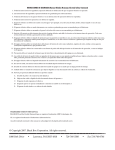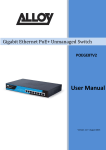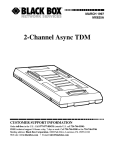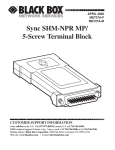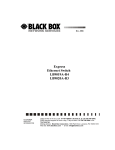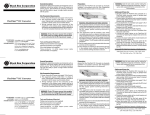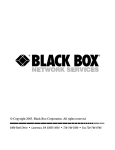Download T1 Provider Backhaul Unit, 1-Port
Transcript
JANUARY 2001 LRA1215A T1 Provider Backhaul Unit, 1-Port t der rovi -Por T1 Pl Unit 1 au ckh Ba Lnk tion Act onnec tC rne 100 Ethe t Fas er Pow Alm tion Lnk onnec T1 C CUSTOMER SUPPORT INFORMATION Order toll-free in the U.S.: Call 877-877-BBOX (outside U.S. call 724-746-5500) FREE technical support 24 hours a day, 7 days a week: Call 724-746-5500 or fax 724-746-0746 Mailing address: Black Box Corporation, 1000 Park Drive, Lawrence, PA 15055-1018 Web site: www.blackbox.com • E-mail: [email protected] FCC INFORMATION FEDERAL COMMUNICATIONS COMMISSION AND INDUSTRY CANADA RADIO FREQUENCY INTERFERENCE STATEMENTS This equipment generates, uses, and can radiate radio frequency energy and if not installed and used properly, that is, in strict accordance with the manufacturer’s instructions, may cause interference to radio communication. It has been tested and found to comply with the limits for a Class A computing device in accordance with the specifications in Subpart J of Part 15 of FCC rules, which are designed to provide reasonable protection against such interference when the equipment is operated in a commercial environment. Operation of this equipment in a residential area is likely to cause interference, in which case the user at his own expense will be required to take whatever measures may be necessary to correct the interference. Changes or modifications not expressly approved by the party responsible for compliance could void the user’s authority to operate the equipment. This digital apparatus does not exceed the Class A limits for radio noise emission from digital apparatus set out in the Radio Interference Regulation of Industry Canada. Le présent appareil numérique n’émet pas de bruits radioélectriques dépassant les limites applicables aux appareils numériques de la classe A prescrites dans le Règlement sur le brouillage radioélectrique publié par Industrie Canada. 1 T1 PROVIDER BACKHAUL UNIT, 1-PORT NORMAS OFICIALES MEXICANAS (NOM) ELECTRICAL SAFETY STATEMENT INSTRUCCIONES DE SEGURIDAD 1. Todas las instrucciones de seguridad y operación deberán ser leídas antes de que el aparato eléctrico sea operado. 2. Las instrucciones de seguridad y operación deberán ser guardadas para referencia futura. 3. Todas las advertencias en el aparato eléctrico y en sus instrucciones de operación deben ser respetadas. 4. Todas las instrucciones de operación y uso deben ser seguidas. 5. El aparato eléctrico no deberá ser usado cerca del agua—por ejemplo, cerca de la tina de baño, lavabo, sótano mojado o cerca de una alberca, etc.. 6. El aparato eléctrico debe ser usado únicamente con carritos o pedestales que sean recomendados por el fabricante. 7. El aparato eléctrico debe ser montado a la pared o al techo sólo como sea recomendado por el fabricante. 8. Servicio—El usuario no debe intentar dar servicio al equipo eléctrico más allá a lo descrito en las instrucciones de operación. Todo otro servicio deberá ser referido a personal de servicio calificado. 9. El aparato eléctrico debe ser situado de tal manera que su posición no interfiera su uso. La colocación del aparato eléctrico sobre una cama, sofá, alfombra o superficie similar puede bloquea la ventilación, no se debe colocar en libreros o gabinetes que impidan el flujo de aire por los orificios de ventilación. 10. El equipo eléctrico deber ser situado fuera del alcance de fuentes de calor como radiadores, registros de calor, estufas u otros aparatos (incluyendo amplificadores) que producen calor. 11. El aparato eléctrico deberá ser connectado a una fuente de poder sólo del tipo descrito en el instructivo de operación, o como se indique en el aparato. 2 NOM STATEMENT 12. Precaución debe ser tomada de tal manera que la tierra fisica y la polarización del equipo no sea eliminada. 13. Los cables de la fuente de poder deben ser guiados de tal manera que no sean pisados ni pellizcados por objetos colocados sobre o contra ellos, poniendo particular atención a los contactos y receptáculos donde salen del aparato. 14. El equipo eléctrico debe ser limpiado únicamente de acuerdo a las recomendaciones del fabricante. 15. En caso de existir, una antena externa deberá ser localizada lejos de las lineas de energia. 16. El cable de corriente deberá ser desconectado del cuando el equipo no sea usado por un largo periodo de tiempo. 17. Cuidado debe ser tomado de tal manera que objectos liquidos no sean derramados sobre la cubierta u orificios de ventilación. 18. Servicio por personal calificado deberá ser provisto cuando: A: El cable de poder o el contacto ha sido dañado; u B: Objectos han caído o líquido ha sido derramado dentro del aparato; o C: El aparato ha sido expuesto a la lluvia; o D: El aparato parece no operar normalmente o muestra un cambio en su desempeño; o E: El aparato ha sido tirado o su cubierta ha sido dañada. 3 T1 PROVIDER BACKHAUL UNIT, 1-PORT TRADEMARKS USED IN THIS MANUAL Any trademarks mentioned in this manual are acknowledged to be the property of the trademark owners. 4 CHAPTER 1: Introduction 1. Introduction These instructions provide basic installation procedures for the T1 Provider Backhaul Unit, 1-Port (LRA1215A). CAUTION Excess static electricity can damage your unit. Use proper staticprotection handling techniques when installing and handling this equipment. 5 T1 PROVIDER BACKHAUL UNIT, 1-PORT 2. Installation 1. Unpack the T1 Provider Backhaul Unit, 1-Port and power supply. 2. Plug the power supply into both the power source and the back of the unit. It does not matter which order. Verify that the Power LED is lit. NOTE The unit’s 100 LED, Act LED, and Lnk LEDs will also light until the T1 link has been established. In addition, the unit won’t present Ethernet Link when the T1 line is not operational. 3. Verify switch configuration is correct for the T1 line (see Table 2-1). Table 2-1. T1 Provider Backhaul Unit 1-Port Switch Configuration Switch #1 Switch #2 DOWN UP DOWN UP *Default settings. DOWN DOWN UP UP Timeslots 1-24 1–18 1–12 1–6 Bandwidth 1.536 Mbps* 1.152 Mbps 768 kbps 384 kbps Switch #3: ESF (DOWN) or SF [D4] (UP) Switch #4: B8ZS (DOWN) or AMI (UP) Switch #5 LBO Low Switch #6 LBO High UP DOWN UP DOWN UP UP DOWN DOWN Switch #7: Local (DOWN) or Loop (UP) Timing Switch #8: Not used 6 Line Attenuation -22.5 dB -15 dB -7.5 dB 0 dB CHAPTER 2: Installation 4. Plug in the T1 connection. Table 2-2. T1 Pinout Information Pin Number Signal 1 2 3 4 5 6 7 8 RX Ring RX Tip Shield Ground* TX Ring TX Tip Shield Ground* Shield Ground* Shield Ground* *Only required when using shielded T1 cable. 5. Verify the T1 connection via the T1 Link LED on the front of the unit. A steadily pulsing T1 Lnk LED (once per second) indicates that a T1 connection is established and operational. 6. Plug in the local Ethernet connection and verify physical link by the Lnk LED on the front of the unit. See Table 2-3. Table 2-3. Ethernet Pinout Pin Number Signal 1 2 3 4 5 6 7 8 RX+ RXTX+ Not used Not used TXNot used Not used NOTE For most applications, use a straight-through Ethernet cable when plugging the Provider Unit into a PC. Use a cross-over cable when plugging into a hub or a switch. Verify the pinout of the Ethernet device into which you are connecting the Provider Unit to determine which type of cable is required. 7 T1 PROVIDER BACKHAUL UNIT, 1-PORT Once the units have established both T1 and Ethernet links on both sides of the connection, normal data communication will flow through the units. This will provide a very long Ethernet connection at T1 or fractional T1 speeds. LED Indicators (also described on bottom label) • T1 Lnk LED: Flashing green indicates that the T1 is operational (no Red Alarm). • T1 Alm LED: Steady/flashing amber indicates a Yellow/Blue Alarm. • Power LED: Steady green indicates normal operation. • 100 LED: Steady green indicates a Fast Ethernet (100-Mbps) connection. • Act LED: Flashing amber indicates activity on the Ethernet segment. • Lnk LED: Steady green indicates that an Ethernet link has been established. 8 © Copyright 2001. Black Box Corporation. All rights reserved. 1000 Park Drive • Lawrence, PA 15055-1018 • 724-746-5500 • Fax 724-746-0746















